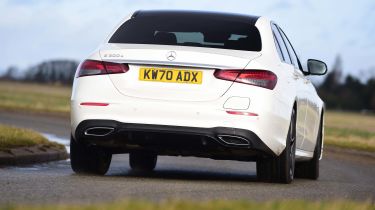Mercedes E-Class hybrid range, MPG, CO2 & charging
The Mercedes E-Class hybrid has a decent electric range and impressive CO2 and MPG figures, on paper at least
| Fuel economy | CO2 emissions | Electric range | Wallbox charge time |
|---|---|---|---|
| 177-217mpg | 33-38g/km | 34-35 miles | 1hr 30mins (0-100%, 7.4kW) |
If your daily round-trip commute is less than 30 miles and you can charge up at home or at work, you could feasibly go weeks without putting fuel in the E-Class hybrid. In fact, unless you’re planning a longer journey, you could run the E 300 e or E 300 de largely on electricity alone.
Conveniently, Mercedes offers two charging cables as standard. The first is a normal three-pin plug for charging from a domestic plug socket, with the other is a Type 2 cable allowing access to most dedicated home wallboxes and public points. The cables are both eight metres long, which is usefully longer than most standard charging cables and will help you reach any awkwardly placed sockets.
Mercedes E-Class hybrid range, MPG & CO2 emissions
Whichever E-Class hybrid you opt for, you’re looking at around 35 miles of electric power before you’ll need to charge up or use the combustion engine. In all cases, these should be viewed as a maximum figure, with variables such as your driving style, the type of roads travelled and the outside temperature all affecting exactly how long the electric motor can drive the car for.
That said, our most recent experience with a facelifted version of the E 300 e petrol saloon showed the E-Class does a pretty good job of prioritising electric power – whereby the range readout dropped near enough in line with distance travelled. All things considered, most drivers should be able to manage 20-25 miles with ease, while those covering most of their daily duties in town should see 30 miles without trouble.
If you tackle long-distance motorway trips on a more regular basis, the diesel E 300 de will probably work out more cost-effective in the long run than the E 300 e petrol, given that it has similar purchase or company-car costs and will return over 50mpg quite easily while the diesel engine is running. Meanwhile, with an empty battery, the petrol will manage more like 35mpg.
Charge time
The E-Class hybrid's 13.5kWh battery can be charged from almost empty to full in around 90 minutes from a typical home wallbox charger, with a maximum charging speed of 7.4kW. Charging from a standard domestic power socket at 3kW will be slower, but still easily accomplished within five hours or so overnight.

